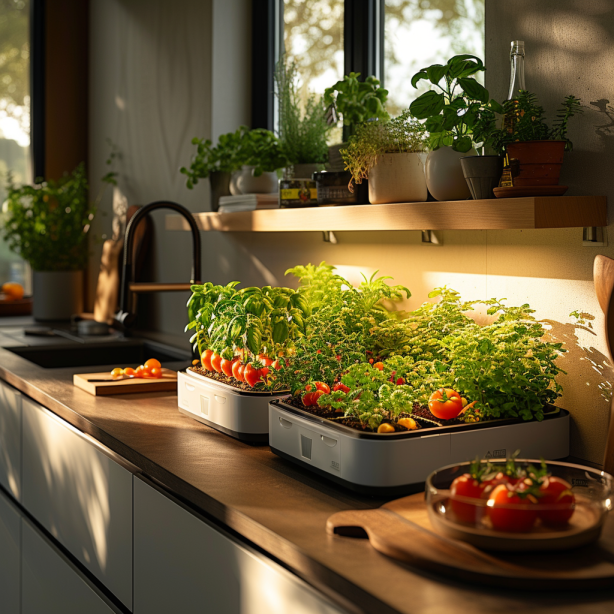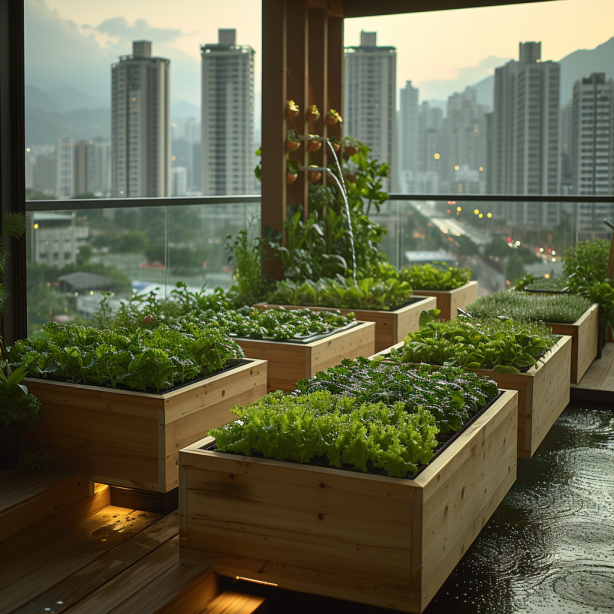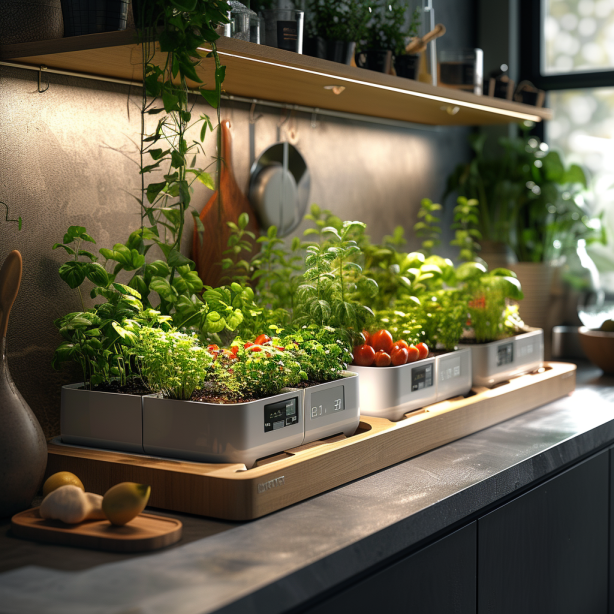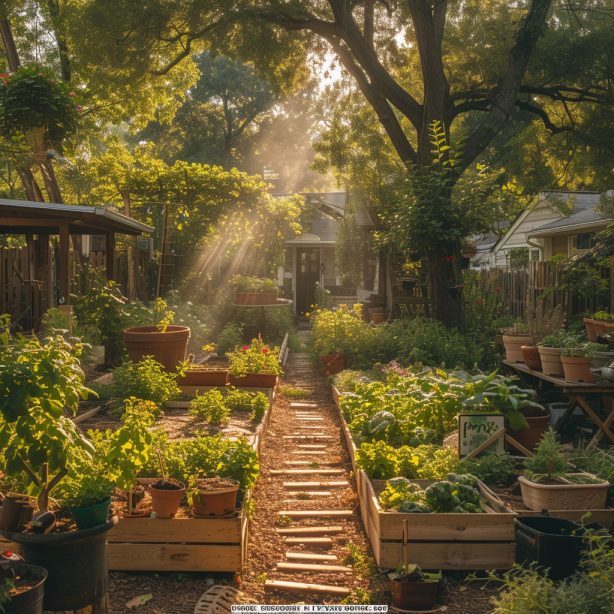According to backyard gardener Jim Smith, “Hydroponics allows for greater control and yields than soil gardening.”
With hydroponics, plants grow in nutrient-rich water rather than soil.
This allows you to precisely control the nutrients plants receive, resulting in faster growth and bigger yields.
But which is better for the average gardener – hydroponics or traditional in-ground gardening?
As an avid gardener who has tried both methods extensively, I can tell you there are…
… pros and cons to each. (1)
Hydroponics requires more equipment and expertise but offers unmatched productivity.
Traditional gardening is simpler but yields less.
By the end, you’ll know which method best fits your needs and lifestyle.
KEY TAKEAWAY
- Hydroponics offers efficient, controlled growth, ideal for urban spaces.
- Traditional gardening fosters a deep connection to nature, promoting a sense of well-being.
What is Hydroponics?
Source: Gardening In Canada
Hydroponics is a really cool way to GROW PLANTS without SOIL! (2)
Instead of being planted in dirt like usual, the plants are placed in a growing MEDIUM…
… like gravel, clay pellets, or rockwool.
Their roots are kept in a nutrient-rich WATER SOLUTION instead.
The main types of hydroponic systems are:
Nutrient Film Technique or NFT
In NFT, plants are grown in shallow sloped GUTTERS or trays that are lined…
… with an inert material like grooved plastic or mineral wool.
A thin stream of nutrient-rich water solution is continuously pumped through the troughs.
This forms a thin “film” that runs along the bottom through which the plant roots dangle down into.
As the solution flows by, the roots absorb all the WATER AND NUTRIENTS…
… they need directly from the medium.
NFT is super awesome because the shallow design allows for TONS of airflow…
… around the extensive root ball.
This great ventilation keeps the roots healthy and promotes FAST growth.
Some veggies that do amazing in NFT include lettuce, herbs, and spinach.
Their roots can triple in size within a week!
Aeroponics

In aeroponic systems, plant roots hang in the air.
Special misters spray a tiny fog of nutrient solution all around the roots.
The mist is so fine it’s like humidity.
Pumps recirculate the solution up to coat the roots.
Since every nook and cranny of the twisting roots gets sprayed, aeroponics makes the roots…
… grow really big, really fast!
Aeroponic plants use up to 90% less water than plants grown in soil.
At the same time, aeroponic plants have yields that are 50% larger!
And with no soil or medium, almost no cleaning is needed between harvests.
Deep Water Culture or DWC
DWC puts plants on rafts or baskets over big reservoirs filled with nutrient solution.
The roots dangle down into the water.
Air pumps add bubbles to oxygenate the solution.
This prevents the roots from rotting.
DWC is easy – just refill the reservoir each week.
Roots stay healthy and produce food with little work.
Great for crops like tomatoes and cucumbers that like “having their feet wet.”
DWC gardens double harvest sizes while cutting water use in half versus soil farming.
In summary, hydroponic growing gives benefits over soil based agriculture.
Hydroponic gardens can grow plants faster, produce more food, and use less water than farms that grow in soil.
Aeroponics and DWC are excellent ways for hydroponic farms…
… to have bountiful harvests of nutritious hydroponic food any time of year.
Their methods are better for the environment too!
Ebb and flow (Flood and Drain)

Ebb and flow is a popular way for farmers to grow hydroponic plants.
It works by briefly flooding shallow planting beds or trays with nutrient-rich water.
The beds hold the hydroponic plants and their roots.
Then the overflow drains away, leaving just moisture for a while before reflooding.
This method gives the plant roots the best of both worlds – a short splash of water…
… and air to the roots, followed by drying time.
Farmers can carefully control how long the flood lasts and how long the drain part takes.
Many big greenhouse farms use ebb and flow to grow lots of hydroponic plants at once.
Drip Systems
Drip systems are like the hoses that water lawns.
Each hydroponic plant gets its own water through thin tubes near the stem.
Nutrient solution slowly drips out bit by bit, right where the roots can drink it up.
No solution is wasted since it only flows out near the roots.
Drip systems pamper plants without making a mess.
Just a tiny amount of water goes to each plant.
Farmers can save on the amounts needed compared to other methods that splash water everywhere.
Timers can also run drip systems while farmers do other chores!
In summary, hydroponic growing methods let you successfully grow bountiful crops…
… inside or out any time of year.
No digging in the dirt, pulling weeds, or hoping for rain showers – science does the plant parenting instead!
This lets farmers try growing hydroponic plants even when nature isn’t cooperating.
It’s one way farmers compare hydroponics vs traditional farming outdoors.
What is Traditional Gardening?

Traditional gardening is the long-standing practice of cultivating plants by…
… growing them directly in nutrient-rich SOIL.
For centuries, this was the main way folks got fresh fruits and veggies.
In soil gardening, plants sink their roots deep into the ground to find nourishment.
Beneficial soil microbes and organisms also work hard to feed our crops.
Worms aerate the dirt and “compost” waste leaves into valuable fertilizer.
Everything lives together in harmony.
Some key steps include:
- CAREFUL SITE SELECTION in a sunny spot with well-draining, uncontaminated soil. Great drainage is a must to avoid flooded roots.
- SOIL PREPARATION like tilling, adding compost or manure, and testing pH levels. This wakes up microbes and makes nutrients available.
- PLANTING SEASONAL SEEDS 1-2 inches deep, or starter plants when soils warm. Crowding deters growth so spacing is important.
- WEEDING is vital to eliminate competition for water/sunlight. Mulching helps smother weeds too.
- PEST PATROL involves regularly checking leaves for insects or spotting fungal/bacterial issues. Removing by hand or using organic sprays protects plants.
- FERTILIZING throughout summer sustains nutrients as plants feed. Worm castings and compost introduce slow-release minerals.
- WATERING ensures soil stays moist around those anchoring root systems, whether with hoses, rain barrels, or irrigation ditches.
When done right, traditional soil gardening is truly the best way to connect with nature…
… and grow the tastiest, most nourishing veggies and herbs.
The rewards are always worth the effort!
While HYDROPONICS has GROWN popular, nothing can quite replace…
… that OLD SCHOOL taste of veggies nurtured in the HOMESTEAD SOIL…
… our families have tended for years.
The tried-and-true ways still work like a charm!
Comparing Hydroponics and Traditional Gardening

Both hydroponic and traditional gardening methods have their pros.
Let’s compare them:
| Category | Hydroponics | Traditional Gardening |
| Efficiency and Yield | Yields are 20-30% higher due to full nutrient/water access without competition. Indoor yields can double under intensive LEDs. | Yields depend on soil nutrients and water available in that plot. Competition for resources can decrease yields. |
| Space Requirements | Allows vertical farming and maximum use of indoor space. Can grow 30x more lettuce per square foot. | Requires large outdoor land areas to cultivate field crops. |
| Water Usage | Uses up to 80% less water since nutrient solution is constantly recycled with no waste. | Subject to outdoor conditions, requires irrigation which uses more water due to evaporation and runoff. |
| Environmental Impact | Preserves natural resources and wildlife habitat by shifting farming indoors. Lowers emissions, runoff and pollution. | Larger acreage required, so greater risk of habitat destruction, emissions from equipment and fertilizer/pesticide runoff. |
| Climate Control | Full control over temp, humidity, CO2, light allows year-round cultivation in any climate or environment. | At the mercy of outdoor weather conditions which can impact crop growth and yield. |
| Crop Variety | Controlled setting enables growing a wider variety of crops including exotic types. | Varieties must be suited to the local climate and soil conditions. |
In conclusion, both approaches have merits.
Hydroponics maximizes yield and resource efficiency within a controlled space.
Traditional soil farming works best for heartier field crops on large, fertile land areas.
Consider your goals and environs to pick the superior method.
Both supply healthy, homegrown goodness!
Additional Benefits of Hydroponics
Hydroponics has some tricks up its sleeve that soil can’t match.
Let’s look closer!
- INITIAL COSTS may seem steep, but factor in savings from no tilling, seeds/compost. Systems pay themselves off within a CROP or two through higher yields. DIY systems keep costs low too.
- FASTER GROWTH happens without limitations of crowded root zones in dirt. Nutrients are precisely tailored and constantly available, allowing plants to double in SIZE within weeks!
- NUTRITIONAL VALUE may even increase with hydroponics. Studies show levels of vitamins, minerals and antioxidants were 15-30% higher than soil-grown. All that matters is a happy root system!
- CUSTOMIZATION AND FUN experiments can be done by adjusting PH, nutrients, lighting schedules – the options are endless for discovering what makes foods grow best. Indoor tinkering extends the growing SEASON year-round too.
- AN ENVIRONMENTALLY-FRIENDLY method since closed-loop systems recycles water constantly with zero chemical run-off. Hydroponics also uses 90% less land than outdoor farms do for the same yields!
In summary, hydroponics upgrades your fruits and veggies with bounty, speed and…
… environmental responsibility.
The SMART choice for the future of feeding our families!
Frequently Asked Questions
What is hydroponic farming?
Hydroponic farming is a method of growing plants like tomatoes, lettuce, herbs and berries without soil.
Instead of soil, the plants are grown in nutrient-rich water or an inert growing medium…
… like gravel, rockwool or coconut coir.
Some key features of hydroponic farming are that it allows year-round…
… growing of plants and controlled growing environments.
What is traditional farming?
Traditional farming is the method of growing plants like vegetables and fruits in soil.
In traditional farming, seeds are planted directly into tilled soil…
… and nurtured with water and nutrients from the soil.
Farmers have been using traditional farming practices for hundreds of years to grow food the natural way.
How do plants grow faster with hydroponics?
Many studies have shown that plants grown hydroponically can often grow faster than plants grown in soil.
With a hydroponic system, farmers have precise control over factors…
… like nutrients, temperature, water, and lighting.
This allows for an optimal growing environment where plants get exactly…
… what they need for healthy growth.
As a result, hydroponically grown plants are often ready for harvest weeks earlier than soil-grown plants.
Are hydroponically grown plants more nutritious?
There is no clear scientific consensus on whether hydroponically grown…
… or traditionally soil-grown plants are more nutritious.
Much depends on the specific growing conditions and nutrients used.
In general, both methods can produce plants that are similar in their nutritional content…
… as long as the hydroponic farmers properly manage pH levels and…
… provide essential nutrients like nitrogen, phosphorus and potassium.
Is hydroponic farming better for the environment?
Hydroponic farming uses far less water than traditional farming and allows for year-round production.
This can help reduce pressure on water supplies and decrease the need…
… to import food over long distances especially in cold regions.
However, running hydroponic systems also requires energy for equipment like lights, pumps and filters.
Overall, more research is needed to understand the full environmental impacts…
… of different farming methods.
For now, both farming practices have benefits and drawbacks for the environment.
What are the most common hydroponic systems?
Some of the most popular hydroponic systems used commercially and by home gardeners include:
- Nutrient Film Technique (NFT) systems,
- Deep Water Culture (DWC) systems,
- Ebb and Flow systems, Wick systems,
- Aeroponics
- Drain to Waste systems.
Each system circulates nutrient-rich water to the plants’ roots while…
… providing structure for aerial plant growth.
Commercial growers often use large-scale NFT, DWC or Ebb and Flow setups…
… to farm hydroponically on a bigger scale.
Is hydroponic farming the future of agriculture?
Many experts believe that as population grows and land for…
… traditional agriculture decreases, hydroponic and other controlled-environment farming methods…
… will play a bigger role in meeting future global food demand.
Hydroponic farming allows much higher yields per acre while using less water and no arable land.
However, traditional farming will likely remain important as well.
It’s possible both farming practices could thrive to grow food for local and…
… global food systems in the future.
More research is still needed but hydroponics show promise as part of sustainable agricultural solutions.
Conclusion
When deciding between hydroponics and traditional in-ground gardening, consider your goals, space, time, and budget.
Hydroponics requires more equipment and expertise but enables greater control and higher yields in a smaller area.
It’s ideal for maximizing productivity.
Traditional gardening is easier for beginners and offers the joy of planting directly in soil.
It’s a lower maintenance option for small backyard veggie patches.
There are great reasons to try both! I suggest starting with traditional gardening…
…due to its simplicity, then experimenting with hydroponics for select plants you want to optimize.
The right choice depends on your personal needs and interests as a gardener.
Let your goals and lifestyle guide you.
References
- https://www.edengreen.com/blog-collection/hydroponics-vs-traditional-farming#:~:text=Hydroponic%20farms%20take%20up%20far,less%20chance%20of%20food%20recalls.
- https://www.nal.usda.gov/farms-and-agricultural-production-systems/hydroponics
Related Articles
- https://tophydroponicgarden.com/hydroponics-introduction/
- https://tophydroponicgarden.com/what-are-the-benefits-of-hydroponics/
- https://tophydroponicgarden.com/plants-grow-slower-in-hydroponics-2/
Was this helpful?

I’m Barrie L., a passionate hydroponic gardening enthusiast dedicated to cultivating thriving, soil-less gardens. With a focus on all things hydroponic, I share my expertise on innovative growing techniques and sustainable practices through my blog, tophydroponicgarden.com. As a seasoned hydroponics specialist, my goal is to inspire and guide fellow gardeners in harnessing the power of water-based cultivation for bountiful and eco-friendly harvests. I’m also an author of the book “Hydroponics For Absolute Beginners: Your Step By Step Guide For How To Create An Hydroponics System At Home Without Soil, For Growing Vegetable, Fruit And Herbs.” which is sold on Amazon. Join me on a journey of redefining the way we cultivate plants, one nutrient-rich solution at a time. Happy growing!


